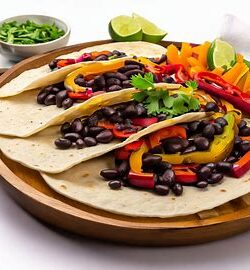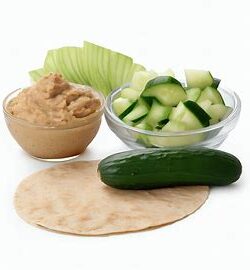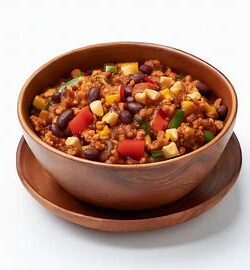Vegetarian Black Bean Fajitas Recipe: Delicious and Nutritious
Vegetarian Black Bean Fajitas is a satisfying and flavorful Mexican-inspired dish. This vegetarian black bean fajita recipe is bursting with deliciousness and packed with essential nutrients. Fajitas are a versatile and beloved dish, and this meatless twist using black beans as the protein source is sure to please both vegetarians and meat-eaters alike.
Let’s dive into the details of this delectable recipe!
Ingredients:
- 1 tablespoon olive oil
- 1 red bell pepper, thinly sliced
- 1 green bell pepper, thinly sliced
- 1 yellow bell pepper, thinly sliced
- 1 red onion, thinly sliced
- 2 cloves garlic, minced
- 1 can (15 ounces) black beans, drained and rinsed
- 1 teaspoon chili powder
- 1/2 teaspoon cumin
- 1/2 teaspoon smoked paprika
- Salt and pepper to taste
- 4-6 flour tortillas
- Toppings: Guacamole, salsa, sour cream, chopped cilantro, lime wedges (optional)
Instructions:
- Heat the olive oil in a large skillet over medium heat. Add the sliced bell peppers and onion to the skillet and sauté for about 5 minutes until they start to soften.
- Add the minced garlic to the skillet and sauté for an additional minute, stirring frequently.
- Incorporate the drained and rinsed black beans into the skillet, along with the chili powder, cumin, smoked paprika, salt, and pepper. Stir well to combine all the ingredients and allow the flavors to meld together for another 2-3 minutes. The beans should be heated through and well-coated with the spices.
- Warm the flour tortillas in a separate pan or wrap them in foil and heat them in the oven for a few minutes.
- To serve, spoon the black bean and vegetable mixture onto the warm tortillas. Top with your favorite toppings such as guacamole, salsa, sour cream, chopped cilantro, or a squeeze of lime juice.
- Roll up the tortillas, tucking in the sides as you go, to create delicious and satisfying fajitas.
Vegetarian black bean fajitas are enjoyed by anyone
These vegetarian black bean fajitas are not only incredibly tasty but also provide a wealth of nutritional benefits. Black beans are an excellent source of plant-based protein, fiber, and various essential minerals such as iron and magnesium. Bell peppers and onions are loaded with vitamins and antioxidants, while spices like chili powder, cumin, and smoked paprika add depth and a delightful kick of flavor.
Get creative with this recipe and add your own personal touches. You can experiment with different types of bell peppers or incorporate other vegetables such as zucchini or mushrooms for added variety. You can also adjust the spice levels to suit your taste preferences. Whether you’re serving these fajitas for a weeknight dinner or a casual gathering, they’re sure to impress!
Not only are these vegetarian black bean fajitas a fantastic option for vegetarians, but they can also be enjoyed by anyone looking to incorporate more plant-based meals into their diet. They are a delicious and nutritious way to satisfy your cravings for Mexican cuisine while promoting a healthy lifestyle.
So, the next time you’re in the mood for a scrumptious vegetarian meal, give this black bean fajita recipe a try. Your taste buds and your body will thank you for it!
HISTORY
The History of Black Bean Fajitas: A Fusion of Flavors and Cultures
Black bean fajitas have become a popular and flavorful dish enjoyed by many, offering a satisfying combination of protein-rich black beans, vibrant vegetables, and warm tortillas. This Tex-Mex delight represents a fusion of Mexican and Southwestern American cuisines, blending traditional ingredients and culinary techniques. Let’s explore the history of black bean fajitas and how they have evolved to become a beloved favorite.
Origins of Fajitas:
To understand the history of black bean fajitas, we must first delve into the origins of fajitas themselves. The term “fajita” is derived from the Spanish word “faja,” meaning belt or girdle. Fajitas originally referred to the skirt steak, a flavorful and often less expensive cut of beef, which was traditionally grilled or cooked over an open fire.
The concept of fajitas can be traced back to the ranching culture of the Rio Grande Valley along the Mexico-Texas border. Cowboys and vaqueros (Mexican cowboys) would often grill skirt steak directly over the fire, utilizing the tough but flavorful cut. These grilled meat strips were then sliced and served with tortillas, onions, peppers, and other accompaniments.
The Introduction of Black Beans:
While traditional fajitas primarily consisted of grilled meat, the inclusion of black beans is a more recent development that reflects a growing interest in vegetarian and plant-based alternatives. Black beans have long been a staple in Mexican and Latin American cuisines, known for their rich flavor, protein content, and versatility in various dishes.
As vegetarian and vegan diets gained popularity, chefs and home cooks started experimenting with alternative fillings for fajitas. Black beans, with their meaty texture and ability to absorb flavors, proved to be an excellent substitute for meat in fajita preparations. This led to the creation of black bean fajitas, providing a delicious and protein-packed option for individuals seeking plant-based alternatives.
Culinary Adaptations and Cultural Influence:
The evolution of black bean fajitas is also influenced by the blending of culinary traditions and flavors. Tex-Mex cuisine, a fusion of Mexican and American influences, has played a significant role in shaping the modern fajita experience. Tex-Mex cuisine combines the flavors, ingredients, and cooking techniques of both cultures, resulting in a unique culinary identity.
The incorporation of black beans into fajitas represents a harmonious fusion of Mexican and Southwestern American flavors. Traditional Mexican ingredients such as onions, bell peppers, and spices are combined with black beans to create a hearty and satisfying filling. The addition of toppings like guacamole, salsa, sour cream, and cheese adds further depth and richness to the dish.
Popularity and Variations:
Black bean fajitas have gained widespread popularity due to their delicious flavor profile, versatility, and health benefits. They have become a go-to option not only for vegetarians and vegans but also for those looking to incorporate more plant-based meals into their diets.
The popularity of black bean fajitas has led to various creative adaptations and variations. Chefs and home cooks have experimented with different seasonings, vegetables, and even the types of tortillas used, ranging from traditional flour tortillas to whole wheat or gluten-free options.
Black bean fajitas have also become a common offering in Mexican and Tex-Mex restaurants, often appearing on menus alongside traditional meat-based fajitas. This inclusion reflects the growing demand for plant-based options and the desire to cater to diverse dietary preferences.
The history of black bean fajitas showcases the evolution of a dish that combines the traditions and flavors of Mexican and Southwestern American cuisines. This fusion of cultures, along with the growing interest in vegetarian




